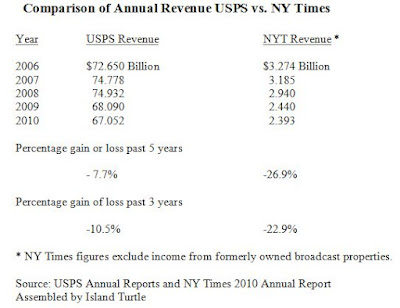The plight of the Post Office and how it is handling its fate stands in stark contrast to that of another private sector group – the newspaper industry. Both are suffering from the effects of internet competition. Both deliver product daily. Both are unionized. Both prefund their pension plans. And both are declining industries. Yet, by and large, newspapers and newspaper groups have kept their heads above water, the Post Office has not. And newspapers have succeeded with far greater rates of revenue declines.
Part of the reason for newspapers resiliency is they have their backs against the wall. They have to solve their own problems. Going to the government trough for a bailout is not an option. It would forever compromise their integrity and believability.
I picked the New York Times as an example, not because it is my favorite paper, it is not. But it is representative of the newspaper industry. It has no broadcast subsidiaries and virtually all its revenue is from newspaper circulation, advertising and more recently internet ads and fees. But the decline in revenue at the Postal Service is nowhere near that of the Times. In the past 5 years, the loss of revenue at the Times has been triple that of the USPS (almost 27%, as opposed to 8% ). Even looking at the 2008 – 2010 year comparison (peak revenue for USPS was 2008) the Times revenues losses were more than double the Postal Service (22.9% vs. 10.5%).
Despite this adversity, the Times is profitable (by a smidgen) and the USPS is facing an $8.3 billion loss. Interestingly, the Times lost money in 2006 and has actually improved its performance. In the same year USPS was well in the black (by its accounting procedures) and is now threatened with insolvency.
Now, why has the Times shown success and the Postal Service not? The Times as most other newspapers has taken aggressive action to control costs. It has reduced force and renegotiated labor contracts. It has sold its broadcasting operations to bolster its cash position. It has outsourced its newsstand sales and bought out its employees to do so. But most of all it has been facing reality. Contrast that to the USPS which recently negotiated its labor contracts with raises it can’t pay. It has lobbied Congress for relief and in general has simply ignored the problem. And it has dug itself into a hole.
The whole mess is an example of the inability of government run enterprises to adapt rapidly to threats. The meddling of Congress is one reason. They refused to approve a rate increase last year the Rate Commission requested. They prefer wasteful Post Offices where they should be either be replaced with private contract operations or simply shut down. They must get out of the way. The example of what the NY Times has accomplished should be used as a model for mail delivery. Nothing should be sacred, be it privatizing major delivery functions, hiring consultants to eliminate inefficiencies, and most of all getting out of the mode of government workplace comfort. Newspapers are reacting to the threat of extinction and making progress. The Postal Service looks for largesse, our largesse.
New management with backbone is the only answer.



No comments:
Post a Comment